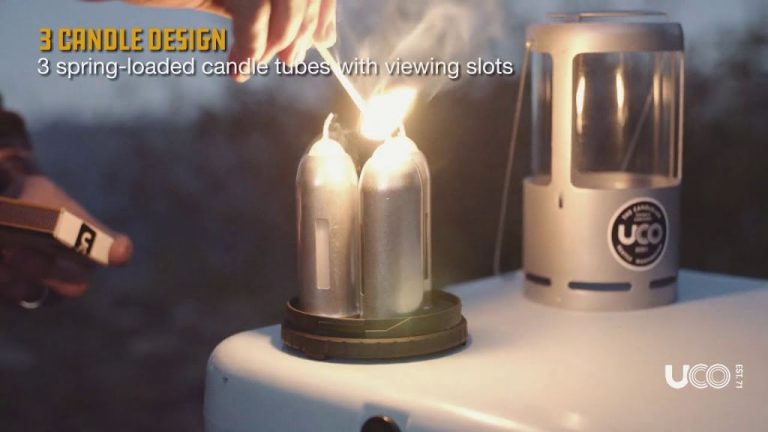How Does A Battery Operated Candle Work?
Battery operated candles have become increasingly popular over the last few decades as an alternative to traditional wax candles. These electric candles mimic the look of real candles with flickering lights, but without the need for an open flame. Battery operated candles are powered by small batteries and use LED or incandescent bulbs to produce light.
Many people choose battery candles for safety reasons since they do not pose a fire hazard like traditional candles. They are ideal for places where you cannot or do not want to have open flames, such as hospitals, nursing homes, children’s bedrooms, and seasonal decorations. Battery operated candles are also convenient since you do not have to light them or replace burnt-out wicks. You can simply turn them on and off with the flip of a switch.
These electric candles come in all shapes and sizes to suit a variety of decor needs. You can find battery operated votives, tapers, pillar candles, candelabras, and even fragrance candles. They provide a classic candle-lit ambiance without the hassle, fire risk, or maintenance of real wax candles. The popularity of battery candles continues to grow as they become more advanced and realistic looking.
Components
Battery-operated candles are made up of several key components that allow them to mimic the look and feel of real wax candles. These include:
Wax Shell
The outside of a battery-operated candle is a wax shell designed to look like a real candle. These shells are typically made from paraffin or soy wax and molded into the shape of a candle, with details like ridges and colors added. The wax shell encases the inner workings and helps give an authentic candle-like appearance.
Light Source
Inside the candle is a small light source, usually an LED or incandescent bulb, that produces the flame effect. LEDs are often preferred as they are energy efficient and long-lasting. The light source emits a soft, warm glow meant to imitate a real flame.
Batteries
Battery-operated candles run on small batteries, often watch or button cell batteries, that power the internal light source. The number and type of batteries can vary based on the size and brightness of the candle. Replacing the batteries allows the candles to be reused over and over.
Switch
A switch, often hidden at the bottom of the candle, allows users to turn the candle on and off. Switches can be simple push buttons or sliding mechanisms. This provides control over when the candle is illuminated.
Wiring
Fine wires connect the batteries to the light source and switch to complete the electrical circuit. The wiring lets electricity flow to power on the light when the switch is activated.
Light Source
Battery powered candles use LED lights as their light source, rather than traditional incandescent bulbs. LEDs are more energy efficient, providing bright light while using very little electricity. This allows the candles to run for many hours on small button cell batteries.
LEDs also give battery candles more versatility with lighting effects. Some candles have flickering LEDs that mimic the natural flicker of a real flame candle. Colors can also be adjusted, with most battery candles available in warm white, but also colors like red, blue, or rainbow. The small size of LEDs allows creative shapes, like flames or flowers.
While incandescent bulbs can technically be used, LEDs are far superior for battery powered candles. They produce more light with less power, enabling the candle to run longer. And their small shape lets manufacturers integrate them seamlessly into candle designs. LED technology has allowed battery operated candles to become affordable, practical, and widely available.
Batteries
Battery operated candles rely on small batteries to power the light source. The most common battery types used are button cell or coin cell batteries. These small, flat batteries are ideal for the compact size of most battery candles.
Coin cell batteries come in different voltages, with 3V being the most popular. Higher voltage batteries will produce a brighter light, but may drain faster. Typical batteries used produce around 20-100 hours of light, but can vary greatly depending on battery performance and quality.
Factors that affect battery life include:
- Battery freshness – Newer batteries last longer
- Battery brand and grade – Premium brands tend to have better longevity
- Usage patterns – Continual versus intermittent use
- Temperature – Colder weather can shorten battery life
So battery selection, storage, and usage can optimize the lifespan of a battery operated candle.
Wax Shell
The shell of a battery operated candle is typically made from a molded wax material. There are several different types of wax that may be used:
– Paraffin wax – This is a smooth, odorless wax made from petroleum. It is inexpensive and easily molded into different shapes.
– Beeswax – A natural wax made by honey bees, beeswax has a subtle honey aroma. It is more expensive than paraffin but creates a more realistic candle.
– Soy wax – An eco-friendly wax made from hydrogenated soybean oil. Soy wax is biodegradable and renewable.
– Gel wax – A mineral oil-based wax with a crystal clear appearance. The realistic crackling as it melts mimics a real candle flame.
The wax is injected into molds to create the candle shell. Molds can be custom designed to produce candles of different shapes, sizes, and colors. The finishing process may involve techniques like tumbling to soften edges or hand painting to add details that mimic real candles.
Advancements in wax technology allow battery operated candles to look quite realistic compared to real wax candles. The flickering light combined with the wax shell makes it difficult to discern that it is not a real flame.
Wiring
The wiring in a battery operated candle connects the light source to the batteries and switch. Thin copper wires run from the base of the light through the candle wax shell to the battery compartment. These wires allow electricity to flow from the batteries to the light when the switch is turned on.
The switch itself interrupts the circuit between the batteries and light. When the switch is in the “off” position, it creates a break in the wiring so electricity cannot flow to illuminate the light. Flipping the switch to the “on” position closes the circuit, allowing electricity to flow uninterrupted through the wires and power on the light.
Proper wiring is essential for the candle to function. The wires need to be well insulated so electricity only flows through the intended path. Loose connections or exposed wires can prevent the light from turning on or even create unsafe conditions. Quality wiring helps ensure smooth lighting operation and longevity of battery operated candles.

Switches
Battery-operated candles come with different types of switches that control the power and light settings. The most common switches are push button, toggle, touch, and remote control:
Push Button Switch
Push button switches require pressing a button to turn the candle on and off. They are simple to use but may need multiple presses to cycle through light modes.
Toggle Switch
Toggle switches allow flipping the switch up or down to turn the candle on and off. Some toggle switches have multiple positions to adjust brightness or flicker settings.
Touch Switch
Touch switches operate by tapping or touching the candle to turn it on and off. They are convenient and easy to use. Some touch sensitive switches enable changing modes by holding a finger on the candle.
Remote Control
Remote control switches allow operating the candle from a distance. They provide the most convenient way to control multiple candles and adjust settings like brightness, timer, and more.
Most battery candle switches are designed to be easy and intuitive to use. Their position on the candle body also varies, with some mounted on the bottom and others discreetly hidden from view.
Safety
Battery operated candles can pose some safety hazards if not used properly. Here are some tips for staying safe:
Fire Safety
Even though battery operated candles don’t have an open flame, they can still start fires. Make sure to keep them away from flammable materials like curtains, tablecloths, and decorative greenery. Don’t leave them unattended or sleep with them on. Place them on a stable, fireproof surface.
Avoiding Burns
The bulb and casing of a battery operated candle can get very hot after being on for a period of time. Make sure to keep them out of reach of children and pets. Allow them to fully cool before moving them or placing them in storage.
Battery Leakage
If batteries leak inside a battery operated candle, it can damage the unit and cause skin irritation if touched. Use good quality batteries, check candles periodically for leakage, and replace batteries as soon as they run low. Properly dispose of used batteries. If skin contact is made with battery acid, rinse the area thoroughly with water.
Maintenance of Battery Operated Candles
Battery operated candles require some basic maintenance to keep them looking and working their best. Here are some tips for cleaning and replacing components when needed:
Cleaning
Dust and dirt can build up on battery operated candles over time. Give them an occasional wipe down with a soft dry cloth to remove any debris. If there are wax or oil stains, use a mild soap and damp cloth to gently clean the candle shell and wipe dry. Avoid submerging the candles in water or using harsh chemicals that could damage the electronics.
Replacing Batteries
When battery operated candles start to flicker, dim, or fail to turn on, it’s time to replace the batteries. Carefully remove any screws or battery covers to access the battery compartment. Use fresh batteries of the same size and type recommended by the manufacturer. Properly dispose of old batteries.
Replacing Bulbs
The light bulb inside a battery operated candle will eventually burn out and need replacing. Bulb types and wattages can vary. Check the user manual or underside of the candle for specifications. Unscrew the spent bulb and screw in an identical new bulb, being careful not to touch the glass with bare fingers. Reassemble the candle and test that the new bulb works.
Environmental Impact of Battery Operated Candles
Battery operated candles can have both positive and negative impacts on the environment. On the positive side, they do not require the burning of wax or oil, which generates smoke and releases emissions. The lack of a real flame also reduces the risk of accidental fires. However, there are some environmental concerns with battery operated candles to consider:
Batteries: The batteries required to power battery candles must be disposed of properly to avoid contaminating landfills. Rechargeable batteries are a better option than single-use batteries. Properly recycling batteries reduces their environmental impact.
Plastics: Most battery operated candles have plastic or acrylic housings. These plastic components do not biodegrade easily. Opting for candles with plant-based plastics could help reduce plastic waste.
Electronic waste: Once battery operated candles reach the end of their usable lifespan, they generate electronic waste. Recycling the metal and plastic components is better for the environment than sending old candle units directly to the landfill.
There are a few alternatives that are more eco-friendly than battery operated candles. Beeswax candles made from natural ingredients burn cleanly. LED flameless candles powered by renewable energy remove the need for batteries. Using real wax candles in moderation or swapping candle time for natural light when possible can also reduce one’s environmental footprint.





